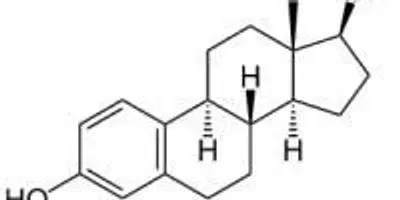 EstradiolImage credit: NEUROtiker, Wikimedia CommonsNewswise — WASHINGTON, D.C., November 24, 2015 – Estrogen is a tiny molecule, but it can have big effects on humans and other animals. Estrogen is one of the main hormones that regulates the female reproductive system – it can be monitored to track human fertility and is sometimes administered to livestock like cows and sheep to control the reproductive cycle.
EstradiolImage credit: NEUROtiker, Wikimedia CommonsNewswise — WASHINGTON, D.C., November 24, 2015 – Estrogen is a tiny molecule, but it can have big effects on humans and other animals. Estrogen is one of the main hormones that regulates the female reproductive system – it can be monitored to track human fertility and is sometimes administered to livestock like cows and sheep to control the reproductive cycle.
Researchers from the Victoria University of Wellington, in New Zealand have developed a new sensor that can detect low levels of E2, one of the primary estrogen hormones, in liquids. The sensor sends an electronic signal is the presence of estrogen and, with further development, could test estrogen levels in bodily fluids or test waterways for estrogen contamination that might pose a risk to humans and the environment.
The sensor, which the researchers describe in a paper in the Journal of Vacuum Science and Technology B, has a simple design, gives real-time readings, could be integrated into an electronic monitoring system and uses very little power–advantages it has over other types of detection methods.
The devices uses small snippets of DNA called aptamers to latch onto estrogen molecules.
Related article: Catalysts Safely Remove Dangerous Compound from Wastewater
“Aptamers are a potentially powerful tool for sensors because they are so versatile and selective,” said Natalie Plank, a researcher who studies nanomaterial device fabrication at the Victoria University of Wellington.
Aptamers are developed through a process similar to natural selection. From a diverse starting population of different DNA or RNA nucleotide sequences, the ones that bind best to the target molecule are selectively enriched, and the process is repeated over multiple “generations.”
The estrogen-binding aptamers that Plank and her colleagues used were first developed by Ken McNatty, a professor of reproductive biology at the Victoria University of Wellington. Once the appropriate sequence of nucleotides is known, the aptamers can be easily generated.
Plank and her team attached their estrogen-binding aptamers to the other important part of their device: the carbon nanotube thin film field effect transistor (CNT FET). CNT FETs work like traditional transistors, but use carbon nanotubes instead of silicon.
Once the researchers attached the aptamers to the carbon nanotubes, they tested the devices in a buffer specifically chosen because it has similar properties to biological fluids. The team tested two different estrogen-binding aptamers: one that was 35 units long and another that was 75 units long. They found that in the presence of estrogen the short aptamer device produced an electrical signal, while the long aptamer device did not.
The researchers theorize this is because of the properties of the buffer solution they used. When the buffer is placed on top of the CNT FET, the voltage across the device causes the molecules in the buffer to arrange into an electrically stable bilayer above the transistor. Estrogen molecules that are caught by the short aptamer disrupt this layer, which in turn changes the current through the device. Estrogen molecules caught by the longer aptamer are likely held above the bilayer, and so do not create the electrical signal.
Plank notes that if water was used in the device, instead of the biologically similar buffer, the long aptamer might also produce a signal because the electrically sensitive layer would be thicker.
Going forward the group plans to test the device in a more complex set-up, for example with an actual biological fluid like urine that has many dissolved components. And the researchers may not confine themselves to estrogen detection. The beauty of the aptamer plus CNT FET sensors is that the aptamers can be easily replaced with new ones that target a different molecule, Plank said. “It’s a very versatile way to build a sensor,” she noted.
The article “Carbon nanotube field effect transistor aptasensors for estrogen detection in liquids,” is authored by Han Yue Zheng, Omar A. Alsager, Cameron S. Wood, Justin M. Hodgkiss and Natalie O. V. Plank. It is published in the Journal of Vacuum Science and Technology B. It can be accessed at http://dx.doi.org/10.1116/1.4935246.
Newswise — WASHINGTON, D.C., November 24, 2015 – Estrogen is a tiny molecule, but it can have big effects on humans and other animals. Estrogen is one of the main hormones that regulates the female reproductive system – it can be monitored to track human fertility and is sometimes administered to livestock like cows and sheep to control the reproductive cycle.
Researchers from the Victoria University of Wellington, in New Zealand have developed a new sensor that can detect low levels of E2, one of the primary estrogen hormones, in liquids. The sensor sends an electronic signal is the presence of estrogen and, with further development, could test estrogen levels in bodily fluids or test waterways for estrogen contamination that might pose a risk to humans and the environment.
To continue reading this article, sign up for FREE to

Membership is FREE and provides you with instant access to eNewsletters, digital publications, article archives, and more.












